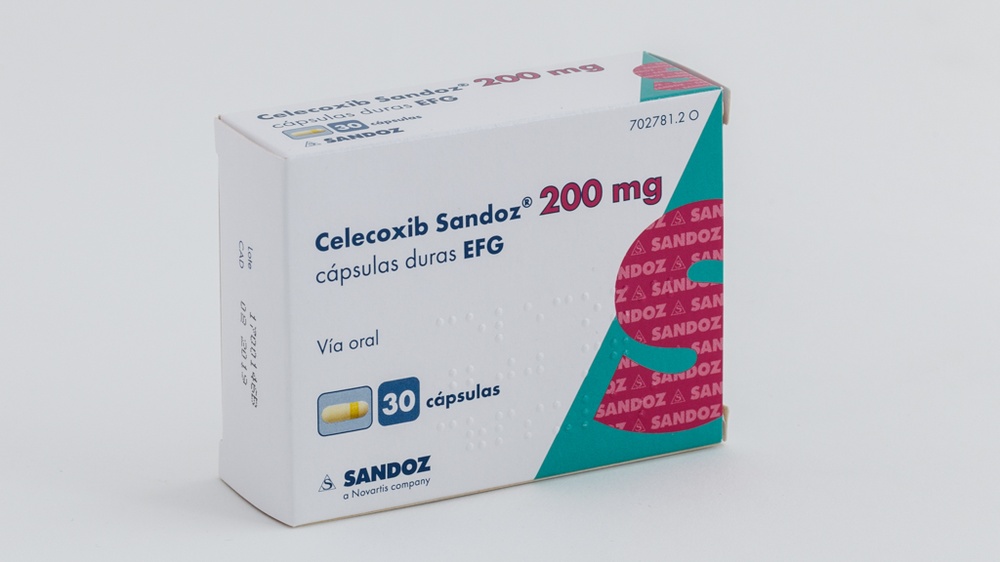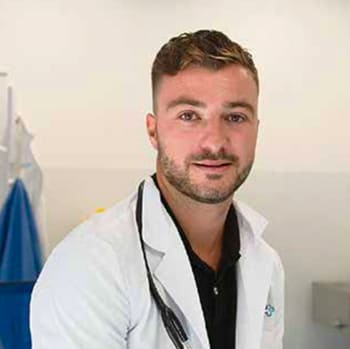

CELECOXIB SANDOZ 200 mg HARD CAPSULES

Ask a doctor about a prescription for CELECOXIB SANDOZ 200 mg HARD CAPSULES

How to use CELECOXIB SANDOZ 200 mg HARD CAPSULES
Introduction
Package Leaflet:information for the user
Celecoxib Sandoz200 mg hard capsules EFG
Read all of this leaflet carefully before you start taking this medicine because it contains important information for you.
- Keep this leaflet. You may need to read it again.
- If you have any further questions, ask your doctor or pharmacist.
- This medicine has been prescribed for you only. Do not pass it on to others. It may harm them, even if their signs of illness are the same as yours.
- If you get any side effects, talk to your doctor or pharmacist. This includes any possible side effects not listed in this leaflet. See section 4.
Contents of the pack and other information
- What is Celecoxib Sandoz and what is it used for
- What you need to know before you take Celecoxib Sandoz
- How to take Celecoxib Sandoz
- Possible side effects
- Storing Celecoxib Sandoz
Contents of the pack and further information
1. What is Celecoxib Sandoz and what is it used for
Celecoxib Sandoz is indicated in adults for the relief of signs and symptoms of rheumatoid arthritis, osteoarthritis, and ankylosing spondylitis.
Celecoxib Sandoz contains the active substance celecoxib. Celecoxib belongs to a class of medicines called non-steroidal anti-inflammatory drugs (NSAIDs), and more specifically to the subgroup known as selective cyclooxygenase-2 (COX-2) inhibitors. Your body produces prostaglandins that can cause pain and inflammation. In conditions such as rheumatoid arthritis or osteoarthritis, your body produces them in larger quantities. Celecoxib Sandoz works by reducing the production of prostaglandins, thereby reducing pain and inflammation.
The medicine will start to take effect a few hours after taking the first dose, but you may not experience a full effect until several days have passed.
2. What you need to know before you take Celecoxib Sandoz
Your doctor has prescribed celecoxib for you. The following information will help you get the best results with this medicine. If you have any other questions, please ask your doctor or pharmacist.
Do not take Celecoxib Sandoz
Tell your doctor if any of the following applies to you, as patients with these conditions should not take celecoxib:
- if you are allergic to celecoxib or any of the other ingredients of this medicine (listed in section 6),
- if you have had any allergic reactionto any medicine in the group known as sulfonamides(e.g. some antibiotics used to treat infections),
- if you currently have a stomach or intestinal ulcer or bleeding,
- if you have previously experienced any of the following symptoms after taking acetylsalicylic acid or any other anti-inflammatory medicine: asthma, nasal polyps, severe nasal congestion, or allergic symptomssuch as skin rash with itching, swelling of the face, lips, tongue, or throat, difficulty breathing, or wheezing,
- if you are pregnant. If you can become pregnant during treatment, you should discuss the use of contraceptive methods with your doctor,
- if you are breast-feeding,
- if you have severe liver disease,
- if you have severe kidney disease,
- if you have inflammatory bowel diseasesuch as ulcerative colitisor Crohn's disease,
- if you have heart failure, diagnosed ischemic heart disease, or cerebrovascular disease, e.g. you have been diagnosed with a heart attack, stroke, or transient ischemic attack (temporary reduction in blood flow to the brain; also known as a "mini-stroke"), angina pectoris, or obstruction of the blood vessels to the heart or brain,
- if you have or have had circulatory problems(peripheral arterial disease) or if you have undergone surgery on the arteries in your legs.
Warnings and precautions
Consult your doctor or pharmacist before starting to take Celecoxib Sandoz if:
- you have previously had a stomach or intestinal ulcer or bleeding(do not take Celecoxib Sandozif you currently have a stomach or intestinal ulcer or bleeding),
- you smoke, have diabetes, high blood pressure, or high cholesterol,
- you have heart, liver, or kidney problems, your doctor may want to monitor you regularly,
- you have fluid retention(such as swollen feet or ankles),
- you are dehydrated, for example, due to an illness with vomiting, diarrhea, or due to the use of diuretics (used to treat excess fluid in the body),
- you have had a severe allergic reactionor a severe skin reaction to any medicine,
- you feel unwell due to an infectionor think you have an infection, as taking celecoxib may mask fever or other signs of infection and inflammation,
- you are over 65 years old, your doctor will want to monitor you regularly.
As with other NSAIDs(e.g. ibuprofen or diclofenac), this medicine may increase your blood pressure, so your doctor may perform regular blood pressure checks.
Some cases of severe liver reactionshave been reported with celecoxib, including severe liver inflammation, liver damage, liver failure (some with a fatal outcome or requiring liver transplantation). Of the cases in which it was reported when the event started, most severe liver reactions occurred within the first month of treatment.
Celecoxib may make it more difficult to become pregnant. You should inform your doctor if you plan to become pregnant or if you are having trouble becoming pregnant (see section "Pregnancy, breast-feeding, and fertility").
Children and adolescents
Celecoxib Sandoz is only for adults. It is not for use in children and adolescents under 18 years of age.
Taking Celecoxib Sandoz with other medicines
Tell your doctor or pharmacist if you are taking, have recently taken, or might take any other medicines:
- dextromethorphan (used to treat cough),
- ACE inhibitors, angiotensin II receptor antagonists, beta-blockers, and diuretics (used to treat high blood pressure and heart failure),
- fluconazole and rifampicin (used to treat bacterial and fungal infections),
- medicines to prevent blood clots, e.g. warfarin or other coumarin-type anticoagulants (newer anticoagulant medicines such as apixaban, dabigatran, or rivaroxaban),
- medicines called corticosteroids (e.g. prednisone),
- antiplatelet therapies, e.g. acetylsalicylic acid (see below),
- acetylsalicylic acid (even at low doses to protect the heart). Celecoxib can be taken with a low dose of acetylsalicylic acid (75 mg or less per day). Ask your doctor for advice before taking this medicine,
- other non-steroidal anti-inflammatory medicines (NSAIDs), e.g. ibuprofen or diclofenac. You should avoid taking celecoxib at the same time as other NSAIDs,
- lithium (used to treat some types of depression),
- other medicines used to treat depression, such as citalopram, imipramine, sleep disorders, high blood pressure, or irregular heartbeat,
- diazepam, a medicine used to treat insomnia or anxiety,
- neuroleptics (used to treat some mental disorders),
- methotrexate (used in rheumatoid arthritis, psoriasis, and leukemia),
- carbamazepine (used to treat seizures/epilepsy/convulsions and some forms of pain or depression),
- barbiturates (used to treat seizures/epilepsy/convulsions and some sleep disorders),
- ciclosporin and tacrolimus (used to suppress the immune system, e.g. after transplants).
Taking Celecoxib Sandoz with alcohol
It is not recommended to consume alcohol while taking celecoxib, as this may increase gastrointestinal problems.
Pregnancy, breast-feeding, and fertility
If you are pregnant or breast-feeding, think you may be pregnant, or are planning to have a baby, ask your doctor or pharmacist for advice before taking this medicine.
- Pregnancy
Celecoxib should not be used by pregnant women or women who may become pregnant (i.e. women of childbearing potential who do not use an adequate contraceptive method) during treatment. If you become pregnant during treatment with celecoxib, you should stop treatment and contact your doctor for alternative treatment.
- Breast-feeding
Celecoxib should not be used during breast-feeding.
- Fertility
NSAIDs, including celecoxib, may make it more difficult to become pregnant. You should inform your doctor if you plan to become pregnant or if you are having trouble becoming pregnant.
Driving and using machines
You should know how you react to celecoxib before driving or using machines. If you feel dizzy or drowsy after taking celecoxib, do not drive or operate machinery until these effects have passed.
Celecoxib Sandoz contains lactose
This medicine contains
Celecoxib Sandoz contains sodium
This medicine contains less than 23 mg of sodium (1 mmol) per hard capsule; this is essentially "sodium-free".
3. How to take Celecoxib Sandoz
Always take this medicine exactly as your doctor or pharmacist has told you. Check with your doctor or pharmacist if you are not sure.
Your doctor will tell you what dose to take. Since the risk of side effects associated with heart problems may increase with the dose and duration of treatment, it is important to use the lowest dose that controls your pain and you should not take Celecoxib Sandoz for longer than necessary to control your symptoms.
Method of administration
Celecoxib is taken orally.
The capsules can be taken at any time of day, with or without food. However, try to take each dose of celecoxib at the same time each day.
If you have difficulty swallowing the capsules: you can sprinkle the entire contents of the capsule onto a level teaspoon of some semi-solid food (such as apple sauce, rice, yogurt, or mashed banana, cold or at room temperature) and swallow it immediately with a glass of water of approximately 240 ml.
To open the capsule, hold it in an upright position to keep the granules at the bottom, then press the top and twist it to remove it, being careful not to spill the contents. Do not chew or crush the granules.
Contact your doctor if, after two weeks of treatment, you do not experience an improvement.
The recommended dose is:
The recommended dose for the treatment of osteoarthritisis 200 mg per day, which may be increased by your doctor to a maximum of 400 mg if necessary.
The dose is usually:
- one 200 mg capsule once a day or
- one 100 mg capsule twice a day.
The recommended dose for the treatment of rheumatoid arthritisis 200 mg per day, which may be increased by your doctor to a maximum of 400 mg if necessary.
The dose is usually:
- one 100 mg capsule twice a day.
A dose of 100 mg twice a day cannot be achieved with Celecoxib Sandoz 200 mg hard capsules. Please consult your doctor.
The recommended dose for the treatment of ankylosing spondylitisis 200 mg per day, which may be increased by your doctor to a maximum of 400 mg if necessary.
The dose is usually:
- one 200 mg capsule once a day or
- one 100 mg capsule twice a day.
Do not take more than 400 mg per dayfor all therapeutic uses.
Kidney or liver problems
Make sure your doctor knows if you have liver or kidney problems, as you may need a lower dose.
Elderly patients
If you are over 65 years old and especially if you weigh less than 50 kg, your doctor may want to monitor you more closely.
Use in children and adolescents
Celecoxib Sandoz is only for adults, it is not indicated in children and adolescents under 18 years of age.
If you take more Celecoxib Sandoz than you should
Do not take more capsules than your doctor has told you to. If you take more celecoxib than you should, contact your doctor, pharmacist, or hospital immediately and take the medicine with you.
If you have taken more Celecoxib Sandoz than you should, contact your doctor, pharmacist, or call the Toxicology Information Service, phone: 91 562 04 20, indicating the medicine and the amount used.
If you forget to take Celecoxib Sandoz
If you forget to take a capsule, take it as soon as you remember. Do not take a double dose to make up for forgotten doses.
If you stop taking Celecoxib Sandoz
Suddenly stopping treatment with celecoxib may cause your symptoms to worsen. Do not stop taking Celecoxib Sandoz unless your doctor tells you to. Your doctor will tell you to reduce the dose over a few days before stopping treatment completely.
If you have any other questions about the use of this medicine, ask your doctor or pharmacist.
4. Possible Adverse Effects
Like all medicines, this medicine can cause adverse effects, although not all people suffer from them.
The adverse effects mentioned below were observed in patients with arthritis who took celecoxib. The adverse effects marked with an asterisk (*) occurred in patients who took Celecoxib Sandoz for the prevention of colon polyps and have been classified taking into account the highest frequency of occurrence. The patients included in these studies took celecoxib at high doses and for a prolonged period.
If you experience any of the following adverse effects, discontinue treatment with Celecoxib Sandoz and inform your doctor immediately:
If you have:
- an allergic reaction such as skin rash, swelling of the face, wheezing or difficulty breathing,
- heart problems such as chest pain,
- severe stomach pain or any sign of bleeding in the stomach or intestines, such as dark urine or stools stained with blood, or blood in vomit,
- a skin reaction such as rash, blisters or peeling of the skin,
- liver failure, symptoms may include nausea (feeling of discomfort), diarrhea, jaundice (yellowing of the skin or eyes),
Possible Adverse Effects
Very Common:may affect more than 1 in 10 people
- increase in blood pressure, including worsening of pre-existing high blood pressure*.
Common:may affect up to 1 in 10 people
- heart attack*,
- fluid retention with swelling of ankles, legs and/or hands,
- urinary tract infection,
- difficult breathing*, sinusitis (inflammation and infection of the paranasal sinuses, obstruction or pain of the paranasal sinuses), stuffy nose or runny nose, sore throat, cough, cold, flu-like symptoms,
- dizziness, difficulty sleeping,
- nausea (feeling of discomfort),
- vomiting*, stomach pain, diarrhea, indigestion, gas,
- difficulty swallowing*,
- rash, itching,
- muscle stiffness,
- headache,
- joint pain,
- worsening of existing allergies,
- accidental injury.
Uncommon:may affect up to 1 in 100 people
- stroke*,
- heart failure, feeling of heartbeat, acceleration of heartbeat,
- abnormalities in blood tests related to the liver,
- abnormalities in blood tests related to the kidneys,
- anemia (changes in red blood cells that can cause fatigue and difficulty breathing),
- anxiety, depression, fatigue, drowsiness, feeling of tingling,
- high levels of potassium in the blood that can cause abnormal heart rhythm or muscle weakness,
- blurred or altered vision, ringing in the ears, mouth pain and ulcers, difficulty hearing*,
- constipation, belching, stomach inflammation (indigestion, stomach pain or vomiting), worsening of stomach or intestinal inflammation,
- leg cramps,
- rash with itching and relief (urticarial wheal),
- eye inflammation,
- difficulty breathing,
- skin discoloration (bruises),
- chest pain (generalized pain not related to the heart),
- swelling of the face.
Rare:may affect up to 1 in 1,000 people
- bleeding in the stomach and intestines (can lead to bloody stools or vomit), inflammation of the intestine or colon,
- ulcers (bleeding) in the throat, stomach or intestines; or rupture of the intestine (can cause stomach pain, fever, nausea, vomiting, intestinal obstruction), dark or black stools, inflammation of the pancreas (can lead to stomach pain), inflammation of the throat (esophagus),
- low levels of sodium in the blood (a condition known as hyponatremia) that can cause fatigue and confusion, muscle spasms, convulsions and coma,
- decrease in the number of white blood cells and platelets in the blood (which can increase the risk of bleeding and bruising),
- difficulty in muscular coordination of movements,
- feeling of confusion, taste disturbances,
- increased sensitivity to light,
- hair loss,
- hallucinations,
- bleeding in the eye,
- acute reaction that can lead to lung inflammation,
- irregular heartbeat,
- flushing,
- blood clots in the blood vessels of the lungs. Symptoms may include difficulty breathing, sharp pains when breathing or collapse,
- severe liver inflammation (hepatitis). Symptoms may include nausea (feeling of discomfort), diarrhea, jaundice (yellowing of the skin and eyes), dark urine, pale stools, easy bleeding, itching or chills,
- acute kidney failure,
- menstrual disorders,
- swelling of the face, lips, mouth, tongue or throat, or difficulty swallowing.
Very Rare:may affect up to 1 in 10,000 people
- severe allergic reaction (including potentially fatal anaphylactic shock),
- severe skin diseases, such as Stevens-Johnson syndrome, exfoliative dermatitis and toxic epidermal necrolysis (can cause rash, blisters or peeling of the skin) and acute generalized exanthematous pustulosis (symptoms include redness of the skin with swelling of areas covered with numerous small pustules),
- a late allergic reaction with possible symptoms such as rash, swelling of the face, fever, swollen glands and abnormalities in clinical test results related to, for example, liver or blood cells (eosinophilia, a type of increase in blood cell count),
- bleeding inside the brain, including fatal cases,
- meningitis (inflammation of the membrane around the brain and spinal cord),
- liver failure, liver damage and severe liver inflammation (fulminant hepatitis) (sometimes with fatal outcome or requiring liver transplant). Symptoms may include nausea (feeling of discomfort), diarrhea, jaundice (yellowing of the skin and eyes), dark urine, pale stools, easy bleeding, itching or chills,
- liver problems (such as cholestasis and cholestatic hepatitis, which may be accompanied by symptoms such as stool discoloration, nausea and yellowing of the skin and eyes),
- kidney inflammation and other kidney problems, such as nephrotic syndrome and minimal change disease, which may be accompanied by symptoms such as water retention (edema), foamy urine, fatigue and loss of appetite,
- seizures and worsening of epilepsy (seizures possibly more frequent and/or severe),
- obstruction of an artery or vein in the eye that leads to partial or complete loss of vision,
- inflammation of the blood vessels (can cause fever, pain, purple spots on the skin),
- reduction in the number of red and white blood cells and platelets in the blood (can cause fatigue, easy bruising, frequent nosebleeds and increased risk of infections),
- muscle pain and weakness,
- taste disturbance,
- loss of taste.
Adverse Effects of Unknown Frequency:cannot be estimated from the available data
- Decrease in female fertility, which is normally reversible if the medication is discontinued.
Adverse Effects Reported in Clinical Trials in Which Celecoxib Was Administered at a Dose of 400 mg/Day for More Than 3 Years, in Patients with Diseases Unrelated to Arthritis or Other Arthritis Conditions, Were:
Common:may affect up to 1 in 10 people
- heart problems: angina pectoris (chest pain),
- stomach problems: irritable bowel syndrome (may include abdominal pain, diarrhea, indigestion and gas),
- kidney stones (can lead to stomach or back pain, blood in the urine), difficulty urinating, high levels of creatinine in the blood (indicates kidney failure),
- weight gain.
Uncommon:may affect up to 1 in 100 people
- deep vein thrombosis (blood clotting usually in the leg, which can cause pain, swelling or redness of the calf or breathing problems),
- stomach problems: stomach infection (can cause irritation or ulcers in the stomach and intestine),
- fracture of lower limbs,
- herpes, skin infection, eczema (dry rash with itching), pneumonia (chest infection with possible symptoms such as cough, fever, difficulty breathing),
- floaters in the eye that cause vision disturbance or blurred vision, conjunctival bleeding, vertigo due to problems in the inner ear, ulcers, inflammation or bleeding of the gums, mouth ulcers,
- excessive urination at night, bleeding from hemorrhoids, frequent bowel movement.
- fat lumps on the skin or other areas, ganglion cyst (painless inflammation in the joints or tendons or around them, in the hand or foot) difficulty speaking, abnormal or heavy vaginal bleeding, chest pain,
- high levels of sodium in blood test results.
Reporting of Adverse Effects
If you experience any type of adverse effect, consult your doctor or pharmacist, even if it is a possible adverse effect that is not listed in this prospectus. You can also report them directly through the Spanish Pharmacovigilance System for Human Use Medicines: https://www.notificaram.es. By reporting adverse effects, you can contribute to providing more information on the safety of this medicine.
5. Storage of Celecoxib Sandoz
Keep this medicine out of the sight and reach of children.
Do not use this medicine after the expiration date that appears on the packaging, after "EXP". The first two digits indicate the month and the last four indicate the year. The expiration date is the last day of the month indicated.
This medicine does not require special storage conditions.
Medicines should not be thrown down the drain or into the trash. Deposit the packaging and medicines that you no longer need in the SIGRE collection point at the pharmacy. In case of doubt, ask your pharmacist how to dispose of the packaging and medicines that you no longer need. This way, you will help protect the environment.
6. Package Contents and Additional Information
Celecoxib Sandoz Composition
- The active ingredient is celecoxib. Each hard capsule contains 200 mg of celecoxib.
- The other ingredients (excipients) are: lactose monohydrate, povidone (E 1201), sodium croscarmellose (E 468), sodium lauryl sulfate (E 487), magnesium stearate (E 572), gelatin (E 441), titanium dioxide (E 171), yellow iron oxide (E 172).
Components of the printing ink: shellac lacquer (E 904), propylene glycol (E 1520), concentrated ammonia solution (E 527) and yellow iron oxide (E 172).
Product Appearance and Package Contents
Hard gelatin capsules, white and opaque. The body of the capsule contains a yellow band and is printed "C9OX-200" in white.
The capsules are presented in ALU/PVC blisters in cardboard boxes.
Package sizes:
Blister: 1, 20, 30, 40, 60 hard capsules.
Not all package sizes may be marketed.
Marketing Authorization Holder and Manufacturer
Marketing Authorization Holder
Sandoz Farmacéutica, S.A.
Centro Empresarial Parque Norte
Edificio Roble
C/ Serrano Galvache, 56
28033 Madrid
Spain
Manufacturer
Synthon Hispania S.L.
Castelló, 1,
08830 Sant Boi de Llobregat,
Spain
or
Synthon BV
Microweg 22
6545 CM, Nijmegen
Netherlands
or
Lek Pharmaceuticals d.d.
Verovskova, 57
1526 Ljubljana
Slovenia
This medicine is authorized in the Member States of the European Economic Area under the following names:
Netherlands: Celecoxib Sandoz 200 mg, capsules hard
Italy: Celecoxib Sandoz
Date of the Last Revision of this Prospectus: January 2021
Detailed information about this medicine is available on the website of the Spanish Agency for Medicines and Health Products (AEMPS) http://www.aemps.gob.es/

How much does CELECOXIB SANDOZ 200 mg HARD CAPSULES cost in Spain ( 2025)?
The average price of CELECOXIB SANDOZ 200 mg HARD CAPSULES in October, 2025 is around 22.28 EUR. Prices may vary depending on the region, pharmacy, and whether a prescription is required. Always check with a local pharmacy or online source for the most accurate information.
- Country of registration
- Average pharmacy price22.28 EUR
- Active substance
- Prescription requiredYes
- Manufacturer
- CompositionLACTOSA MONOHIDRATO (24,80 mg mg), CROSCARMELOSA SODICA (2,70 mg mg), LAURILSULFATO DE SODIO (6,09 mg mg), LACTOSA MONOHIDRATO (24,80 mg mg), PROPILENGLICOL (C.S Porcentaje peso/peso mg)
- This information is for reference only and does not constitute medical advice. Always consult a licensed doctor before taking any medication. Oladoctor is not responsible for medical decisions based on this content.
- Alternatives to CELECOXIB SANDOZ 200 mg HARD CAPSULESDosage form: CAPSULE, 200 mgActive substance: celecoxibManufacturer: Viatris Healthcare LimitedPrescription requiredDosage form: CAPSULE, 200 mgActive substance: celecoxibManufacturer: Laboratorio Stada S.L.Prescription requiredDosage form: CAPSULE, 100 mg of celecoxibActive substance: celecoxibManufacturer: Viatris Healthcare LimitedPrescription required
Online doctors for CELECOXIB SANDOZ 200 mg HARD CAPSULES
Discuss dosage, side effects, interactions, contraindications, and prescription renewal for CELECOXIB SANDOZ 200 mg HARD CAPSULES – subject to medical assessment and local rules.














